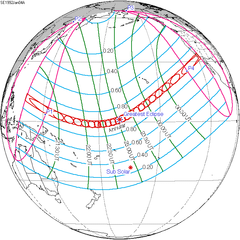January 2001 lunar eclipse
| Total Lunar Eclipse 9 January 2001 | |
|---|---|
 Totality as viewed from Oria, Italy. | |
 The moon passes west to east (right to left) across the Earth's umbral shadow, shown in hourly intervals. | |
| Series (and member) | 134 (26 of 73) |
| Gamma | 0.3720 |
| Magnitude | 1.1889 |
| Duration (hr:mn:sc) | |
| Totality | 1:01:02 |
| Partial | 3:16:19 |
| Penumbral | 5:11:02 |
| Contacts (UTC) | |
| P1 | 17:45:04 |
| U1 | 18:42:27 |
| U2 | 19:50:05 |
| Greatest | 20:20:35 |
| U3 | 20:51:07 |
| U4 | 21:58:45 |
| P4 | 22:56:06 |
 The Moon passed straight through the center of the Earth's shadow at the descending node in Gemini. | |
A total lunar eclipse took place on Tuesday 9 January 2001, the first of three lunar eclipses in 2001. A shallow total eclipse saw the Moon in relative darkness for 1 hour 1 minute and 2 seconds. The Moon was 18.89% of its diameter into the Earth's umbral shadow, and totality was observed in all of Europe, Africa, and Asia. The partial eclipse lasted for 3 hours 16 minutes and 19 seconds and was visible in parts of north-eastern North America and Australia. It is the only total eclipse of 2001. It was visible over Asia and Western Australia with the Middle East getting mid eclipse at midnight.
Visibility[edit]
Related lunar eclipses[edit]
Eclipses of 2001[edit]
- A total lunar eclipse on 9 January.
- A total solar eclipse on 21 June.
- A partial lunar eclipse on 5 July.
- An annular solar eclipse on 14 December.
- A penumbral lunar eclipse on 30 December.
Lunar year series[edit]
| Lunar eclipse series sets from 1998–2002 | ||||||||
|---|---|---|---|---|---|---|---|---|
| Descending node | Ascending node | |||||||
| Saros | Date Viewing |
Type Chart |
Gamma | Saros | Date Viewing |
Type Chart |
Gamma | |
| 109 | 1998 Aug 08
|
penumbral
|
1.4876 | 114 | 1999 Jan 31
|
penumbral
|
−1.0190 | |
| 119 | 1999 Jul 28
|
partial
|
0.7863 | 124
|
2000 Jan 21
|
total
|
−0.2957 | |
| 129 | 2000 Jul 16
|
total
|
0.0302 | 134
|
2001 Jan 09
|
total
|
0.3720 | |
| 139 | 2001 Jul 05
|
partial
|
−0.7287 | 144 | 2001 Dec 30
|
penumbral
|
1.0732 | |
| 149 | 2002 Jun 24
|
penumbral
|
−1.4440 | |||||
| Last set | 1998 Sep 06 | Last set | 1998 Mar 13 | |||||
| Next set | 2002 May 26 | Next set | 2002 Nov 20 | |||||
Half-Saros cycle[edit]
A lunar eclipse will be preceded and followed by solar eclipses by 9 years and 5.5 days (a half saros).[1] This lunar eclipse is related to two annular solar eclipses of Solar Saros 141.
| 4 January 1992 | 15 January 2010 |
|---|---|

|

|
See also[edit]
References[edit]
- ^ Mathematical Astronomy Morsels, Jean Meeus, p.110, Chapter 18, The half-saros
External links[edit]
- Saros cycle 134
- 2001 Jan 09 chart: Eclipse Predictions by Fred Espenak, NASA/GSFC
- Jan. 9, 2001 Lunar Eclipse Gallery
- NASA Astronomy Picture of the Day: Total lunar eclipse (18 January 2001)
- NASA 2001 Jan 09: Total Lunar Eclipse
- Total Lunar Eclipses seen from Cape Town[permanent dead link] Total lunar eclipse, January 9, 2001.




